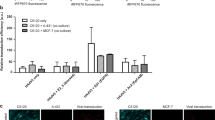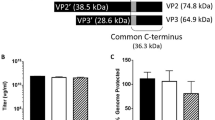Abstract
Adenovirus (Ad)-mediated delivery of anti-angiogenic molecules into tumors constitutes an appealing approach for growth inhibition. However, lack of expression on tumors of Ad receptors leads to weak tumor transduction. Therefore, to provide Ad with a new entry pathway into tumors, an NGR peptide was inserted into either fiber (AdFNGR) or hexon (AdHNGR) capsid proteins. This strategy provided Ad with a very efficient entry pathway in both endothelial cells and tumor cells, with the highest efficacy observed for AdHNGR. Using pharmacological, biochemical and genetic approaches, AdHNGR and AdFNGR were shown to bind not only to CD13 receptor, but also to αvβ3 integrins. Both vectors were efficient tools to deliver angiostatin K1-5 cDNA into endothelial cells, thus leading to a dramatic inhibition of their proliferation and increased cell death. Although AdHNGR and Adwt were found to display similar gene transduction efficacy in Lewis lung carcinoma (LLC), pseudotyping AdHNGR with an Ad3-fiber unmasked the ability of NGR-peptide to target these tumors. As a result, delivery of angiostatin K1-5 cDNA into highly aggressive tumors translated into a stronger inhibition of their growth. Altogether, our results suggest that NGR-bearing Ad are valuable tools to realize the potential of this anti-angiogenic approach to anti-tumor therapy.
This is a preview of subscription content, access via your institution
Access options
Subscribe to this journal
Receive 12 print issues and online access
$259.00 per year
only $21.58 per issue
Buy this article
- Purchase on Springer Link
- Instant access to full article PDF
Prices may be subject to local taxes which are calculated during checkout






Similar content being viewed by others
References
Folkman J . Tumor angiogenesis: therapeutic implications. N Engl J Med 1971; 285: 1182–1186.
Rafii S, Lyden D . Cancer. A few to flip the angiogenic switch. Science (New York, NY) 2008; 319: 163–164.
Folkman J . Angiogenesis: an organizing principle for drug discovery? Nat Rev Drug Discov 2007; 6: 273–286.
Nyberg P, Xie L, Kalluri R . Endogenous inhibitors of angiogenesis. Cancer res 2005; 65: 3967–3979.
Soff GA . Angiostatin and angiostatin-related proteins. Cancer Metastasis Rev 2000; 19: 97–107.
O’Reilly MS, Holmgren L, Shing Y, Chen C, Rosenthal RA, Moses M et al. Angiostatin: a novel angiogenesis inhibitor that mediates the suppression of metastases by a Lewis lung carcinoma. Cell 1994; 79: 315–328.
Galaup A, Magnon C, Rouffiac V, Opolon P, Opolon D, Lassau N et al. Full kringles of plasminogen (aa 1-566) mediate complete regression of human MDA-MB-231 breast tumor xenografted in nude mice. Gene therapy 2005; 12: 831–842.
Folkman J . Antiangiogenesis in cancer therapy--endostatin and its mechanisms of action. Exp cell res 2006; 312: 594–607.
Griscelli F, Li H, Bennaceur-Griscelli A, Soria J, Opolon P, Soria C et al. Angiostatin gene transfer: inhibition of tumor growth in vivo by blockage of endothelial cell proliferation associated with a mitosis arrest. Proc Natl Acad Sci USA 1998; 95: 6367–6372.
Wen XY, Bai Y, Stewart AK . Adenovirus-mediated human endostatin gene delivery demonstrates strain-specific antitumor activity and acute dose-dependent toxicity in mice. Hum Gene Ther 2001; 12: 347–358.
Mahasreshti PJ, Kataram M, Wang MH, Stockard CR, Grizzle WE, Carey D et al. Intravenous delivery of adenovirus-mediated soluble FLT-1 results in liver toxicity. Clin Cancer Res 2003; 9: 2701–2710.
Verheul HM, Pinedo HM . Possible molecular mechanisms involved in the toxicity of angiogenesis inhibition. Nat Rev Cancer 2007; 7: 475–485.
Coyne CB, Bergelson JM . CAR: a virus receptor within the tight junction. Adv Drug Deliv Rev 2005; 57: 869–882.
Meier O, Greber UF . Adenovirus endocytosis. J Gene Med 2004; 6 (Suppl 1): S152–S163.
Li Y, Pong RC, Bergelson JM, Hall MC, Sagalowsky AI, Tseng CP et al. Loss of adenoviral receptor expression in human bladder cancer cells: a potential impact on the efficacy of gene therapy. Cancer res 1999; 59: 325–330.
Pearson AS, Koch PE, Atkinson N, Xiong M, Finberg RW, Roth JA et al. Factors limiting adenovirus-mediated gene transfer into human lung and pancreatic cancer cell lines. Clin Cancer Res 1999; 5: 4208–4213.
Miller CR, Buchsbaum DJ, Reynolds PN, Douglas JT, Gillespie GY, Mayo MS et al. Differential susceptibility of primary and established human glioma cells to adenovirus infection: targeting via the epidermal growth factor receptor achieves fiber receptor-independent gene transfer. Cancer res 1998; 58: 5738–5748.
Cripe TP, Dunphy EJ, Holub AD, Saini A, Vasi NH, Mahller YY et al. Fiber knob modifications overcome low, heterogeneous expression of the coxsackievirus-adenovirus receptor that limits adenovirus gene transfer and oncolysis for human rhabdomyosarcoma cells. Cancer res 2001; 61: 2953–2960.
Okegawa T, Li Y, Pong RC, Bergelson JM, Zhou J, Hsieh JT . The dual impact of coxsackie and adenovirus receptor expression on human prostate cancer gene therapy. Cancer res 2000; 60: 5031–5036.
Okegawa T, Pong RC, Li Y, Bergelson JM, Sagalowsky AI, Hsieh JT . The mechanism of the growth-inhibitory effect of coxsackie and adenovirus receptor (CAR) on human bladder cancer: a functional analysis of car protein structure. Cancer res 2001; 61: 6592–6600.
Mathis JM, Stoff-Khalili MA, Curiel DT . Oncolytic adenoviruses—selective retargeting to tumor cells. Oncogene 2005; 24: 7775–7791.
Dmitriev I, Krasnykh V, Miller CR, Wang M, Kashentseva E, Mikheeva G et al. An adenovirus vector with genetically modified fibers demonstrates expanded tropism via utilization of a coxsackievirus and adenovirus receptor-independent cell entry mechanism. J Virol 1998; 72: 9706–9713.
Hemminki A, Belousova N, Zinn KR, Liu B, Wang M, Chaudhuri TR et al. An adenovirus with enhanced infectivity mediates molecular chemotherapy of ovarian cancer cells and allows imaging of gene expression. Mol Ther 2001; 4: 223–231.
Mizuguchi H, Koizumi N, Hosono T, Utoguchi N, Watanabe Y, Kay MA et al. A simplified system for constructing recombinant adenoviral vectors containing heterologous peptides in the HI loop of their fiber knob. Gene Therapy 2001; 8: 730–735.
Kanerva A, Wang M, Bauerschmitz GJ, Lam JT, Desmond RA, Bhoola SM et al. Gene transfer to ovarian cancer versus normal tissues with fiber-modified adenoviruses. Mol Ther 2002; 5: 695–704.
Koizumi N, Mizuguchi H, Utoguchi N, Watanabe Y, Hayakawa T . Generation of fiber-modified adenovirus vectors containing heterologous peptides in both the HI loop and C terminus of the fiber knob. J Gene Med 2003; 5: 267–276.
Nakamura T, Sato K, Hamada H . Effective gene transfer to human melanomas via integrin-targeted adenoviral vectors. Hum Gene Ther 2002; 13: 613–626.
Wickham TJ, Tzeng E, Shears 2nd LL, Roelvink PW, Li Y, Lee GM et al. Increased in vitro and in vivo gene transfer by adenovirus vectors containing chimeric fiber proteins. J Virol 1997; 71: 8221–8229.
Wu H, Han T, Lam JT, Leath CA, Dmitriev I, Kashentseva E et al. Preclinical evaluation of a class of infectivity-enhanced adenoviral vectors in ovarian cancer gene therapy. Gene Therapy 2004; 11: 874–878.
Arap W, Pasqualini R, Ruoslahti E . Cancer treatment by targeted drug delivery to tumor vasculature in a mouse model. Science (New York, NY) 1998; 279: 377–380.
Curnis F, Arrigoni G, Sacchi A, Fischetti L, Arap W, Pasqualini R et al. Differential binding of drugs containing the NGR motif to CD13 isoforms in tumor vessels, epithelia, and myeloid cells. Cancer Res 2002; 62: 867–874.
Koivunen E, Wang B, Ruoslahti E . Isolation of a highly specific ligand for the alpha 5 beta 1 integrin from a phage display library. J Cell Biol 1994; 124: 373–380.
Koivunen E, Arap W, Rajotte D, Lahdenranta J, Pasqualini R . Identification of receptor ligands with phage display peptide libraries. J Nucl Med 1999; 40: 883–888.
Shim JS, Kim JH, Cho HY, Yum YN, Kim SH, Park HJ et al. Irreversible inhibition of CD13/aminopeptidase N by the antiangiogenic agent curcumin. Chem Biol 2003; 10: 695–704.
Reaux A, Fournie-Zaluski MC, David C, Zini S, Roques BP, Corvol P et al. Aminopeptidase A inhibitors as potential central antihypertensive agents. Proc Natl Acad Sci USA 1999; 96: 13415–13420.
Vigant F, Descamps D, Jullienne B, Esselin S, Connault E, Opolon P et al. Substitution of hexon hypervariable region 5 of adenovirus serotype 5 abrogates blood factor binding and limits gene transfer to liver. Mol Ther 2008; 16: 1474–1480.
Sirena D, Lilienfeld B, Eisenhut M, Kalin S, Boucke K, Beerli RR et al. The human membrane cofactor CD46 is a receptor for species B adenovirus serotype 3. J Virol 2004; 78: 4454–4462.
Majhen D, Gabrilovac J, Eloit M, Richardson J, Ambriovic-Ristov A . Disulfide bond formation in NGR fiber-modified adenovirus is essential for retargeting to aminopeptidase N. Biochem Biophys Res Commun 2006; 348: 278–287.
Corti A, Curnis F, Arap W, Pasqualini R . The neovasculature homing motif NGR: more than meets the eye. Blood 2008; 112: 2628–2635.
Pasqualini R, Arap W, McDonald DM . Probing the structural and molecular diversity of tumor vasculature. Trends Mol Med 2002; 8: 563–571.
Dechecchi MC, Tamanini A, Bonizzato A, Cabrini G . Heparan sulfate glycosaminoglycans are involved in adenovirus type 5 and 2-host cell interactions. Virology 2000; 268: 382–390.
Vigne E, Mahfouz I, Dedieu JF, Brie A, Perricaudet M, Yeh P . RGD inclusion in the hexon monomer provides adenovirus type 5-based vectors with a fiber knob-independent pathway for infection. J Virol 1999; 73: 5156–5161.
Martin K, Brie A, Saulnier P, Perricaudet M, Yeh P, Vigne E . Simultaneous CAR- and alpha V integrin-binding ablation fails to reduce Ad5 liver tropism. Mol Ther 2003; 8: 485–494.
Von Seggern DJ, Huang S, Fleck SK, Stevenson SC, Nemerow GR . Adenovirus vector pseudotyping in fiber-expressing cell lines: improved transduction of Epstein-Barr virus-transformed B cells. J Virol 2000; 74: 354–362.
Naldini L, Blomer U, Gallay P, Ory D, Mulligan R, Gage FH et al. In vivo gene delivery and stable transduction of nondividing cells by a lentiviral vector. Science (New York, NY) 1996; 272: 263–267.
Bergelson JM, Cunningham JA, Droguett G, Kurt-Jones EA, Krithivas A, Hong JS et al. Isolation of a common receptor for Coxsackie B viruses and adenoviruses 2 and 5. Science (New York, NY) 1997; 275: 1320–1323.
Liszewski MK, Tedja I, Atkinson JP . Membrane cofactor protein (CD46) of complement. Processing differences related to alternatively spliced cytoplasmic domains. J Biol Chem 1994; 269: 10776–10779.
Edgell CJ, McDonald CC, Graham JB . Permanent cell line expressing human factor VIII-related antigen established by hybridization. Proc Natl Acad Sci USA 1983; 80: 3734–3737.
Acknowledgements
We thank C Ransy for Ad titration, F Larbret and Y Lecluse for cell sorting, A Galaup for providing us with K1-5 plasmid. We are also very grateful to all the staff of the animal facilities for technical help and animal care. The work was funded by the CNRS and the Association pour la Recherche contre le Cancer (ARC) to KB. BJ and FV received fellowships from the Ministère de la Recherche et de la Technologie; BJ received other fellowships from the Société Française du Cancer and ARC; FV received other fellowships from the Association Française contre les Myopathies and the Société Française d’Hématologie.
Author information
Authors and Affiliations
Corresponding author
Additional information
Supplementary Information accompanies the paper on Gene Therapy website (http://www.nature.com/gt)
Rights and permissions
About this article
Cite this article
Jullienne, B., Vigant, F., Muth, E. et al. Efficient delivery of angiostatin K1-5 into tumors following insertion of an NGR peptide into adenovirus capsid. Gene Ther 16, 1405–1415 (2009). https://doi.org/10.1038/gt.2009.97
Received:
Revised:
Accepted:
Published:
Issue Date:
DOI: https://doi.org/10.1038/gt.2009.97
Keywords
This article is cited by
-
Aluminum particles generated during millisecond electric pulse application enhance adenovirus-mediated gene transfer in L929 cells
Scientific Reports (2021)
-
Peptide targeting of adenoviral vectors to augment tumor gene transfer
Cancer Gene Therapy (2012)
-
CIP-13F, a novel aminopeptidase N (APN/CD13) inhibitor, inhibits Lewis lung carcinoma growth and metastasis in mice
Cancer Chemotherapy and Pharmacology (2012)



